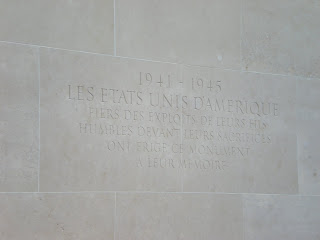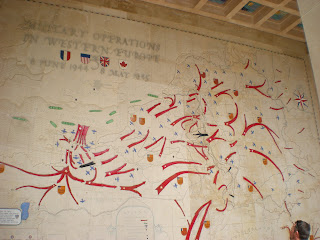I woke up around 6 in order to get to the bus on time. My host mom was very nice and made sure I was awake. Unfortunately, my French-speaking ability is nil before 8 AM. I eventually understood that she was making sure I would be on time. I managed to get out of bed and make my way to l'Opera de Paris, where our bus would leave from.
Sam, who lives close to me, and I met at the metro stop and made our way there. Of course, the minute we climbed out of the subway it started raining. Hard. We didn't have to wait long to get on the bus however.

Paris was pretty empty that morning, except for early-morning commuters. We drove past all of the sights down the Champs Elysees. One of our French teachers told us that we might see police cars because President Sarkozy jogs there every morning. (We didn't).
Almost everyone took the first hour on the bus to sleep/wake up. We got to a truck stop and got our requisite caffeine, and after that, the ride was much more fun. The French students gave us a quiz on French culture and taught us a French song.

One could soon tell that we were getting farther out of the city. Eventually we arrived in Caen, the town that had the WWII museum that we would be visiting, as well as the hotel where we would be staying that night.


 It is difficult to take a picture of road signs in a fast-moving bus.
It is difficult to take a picture of road signs in a fast-moving bus.First stop was the museum/Caen memorial. People decided to put the WWII museum there because the town had been a German stronghold during the Battle of Normandie.

When we first walked into the building, there was a plane hanging from the ceiling. Impressive.


I walked through the exhibits which showed, chronologically, the different eras of the war. The propaganda posters were very interesting.



 There was even a sea mine (deactivated, of course).
There was even a sea mine (deactivated, of course).
A few of the exhibits were a little hard to handle. One of the great things about the museum was that it didn't shy away from showing the ugly truth of the war. There were films showing combat, and those were definitely not for the faint of heart. We also watched a very interesting film on D-Day that showed action simultaneously from the Allied/German perspective.
Upon leaving, we waited outside for our bus to pick us up. A man walked into the museum leaving his dog outside. He just told the dog to lie down and it did. I am pretty sure it just waited there for him.

Our next stop was the American cemetary above Omaha Beach. This was on a piece of land given to the United States from France. The U.S. was given this land in particular because the troops on Omaha Beach had had one of the worst struggles.




Looking at the beach, it was very hard to imagine what had happened there. It was so peaceful and beautiful. I couldn't imagine being a soldier coming onto this beach after bobbing in the ocean for a six-hour crossing from England.



In the memorial there were maps of combat dates, etc.


We got shown a few graves. All the gravestones were made out of white marble (a gift from Italy) and face the United States. If a soldier had on his dog tags that he was Jewish, he was given a marble star of David.

Theodore Roosevelt Jr. was one of the graves that we were shown specifically. He was too old to participate in D-Day, but he did anyway. He was given the medal of honor for finding a safer landing place for his troops (ensuring that not as many of them died). He died of a heart attack about a month after D-Day. His brother, who was killed in France in WWI, was reburied next to him.
 If a soldier is unidentified, he is buried under a cross like this: "A Comrade in Arms, Known but to God."
If a soldier is unidentified, he is buried under a cross like this: "A Comrade in Arms, Known but to God."
I also took a picture of every Minnesota-based person I could find. Here is one who died on D-Day.



We all got back on the bus to head down to Omaha beach itself. Once again, it was too beautiful to believe.



It was very windy though.

I collected some of the sand to bring home. I will put it in small bottles and give it to anyone who wants some (like my grandpa). If anyone knows anyone who fought in Normandie, I would gladly give them some.
One of the reasons the fighting in Normandy was so intense was that Germans had built fortifications among the cliffs like this one:

After the beach, back on the bus AGAIN to go see another piece of land that France had given the U.S. We saw some cows on the way there.

This was the sight of a skirmish that happened before D-Day. Some American Rangers were given the task of destroying four long-range guns that would have been capable of firing to reach two of the beaches. The only problem was, the rangers needed to scale a huge cliff in order to get to the guns.
They tried to time it following a huge American air-strike, but, unfortunately the timing wasn't right, and the rangers had to scale the cliff under German fire. Those that made it up alive realized that the guns were decoys anyway.
Luckily, some of the surviving soldiers discovered the guns a few miles away and destroyed them.
This landscape hadn't been touched since that battle. It was possible that American soldiers were still buried in the field (hence why the land was given to the U.S.)




It honestly looked like a golf course. It was hard to believe that that's what bomb craters look like so much later.
We once again climbed on the bus, this time to go visit the German cemetary. It was very interesting to see this because it was so different from the American one. First of all, Germany was not given the land (a nonprofit maintains it). Second, there is always danger that neo-Nazis might show up, so they are extra vigilant.



It was sad to realize that a lot of the soldiers in there were not even German, but residents of occupied countries that were forced to fight.
We drove back to Caen and checked into our hotel for the night. I was tired and hungry, and joined up with a few other people. We went to a creperie! It was delicious. It is customary to get one savory crepe and one dessert. I am on board with this.





No comments:
Post a Comment